 Defined as a dog with low body, short legs, long, strong and well muscled.
The head must be carried erect with an expression of challenge and
intelligence.
Defined as a dog with low body, short legs, long, strong and well muscled.
The head must be carried erect with an expression of challenge and
intelligence.
This is a translation of an article published by Dr. Manuel Gutierrez, DVM and dachshund breeder. Our intention is to offer his knowledge about the standardand possible defects found in dachshunds. The science of this article, basedupon the German standard, is accepted and used by the majority of the European countries and many other members of the FCI(Federation Cynologique Internationale). This article permits you to obtain sufficient knowledge about how dachshunds are judged in Europe. As you will see, thesejudgements are more strict than in the USA, especially in regards to defects. We hope that this knowledge will permit our fellow DCA members to know what to expect when deciding to participate with doxies in an international show.
Translated by Donna D. McElroy & Adolfo Alonso-Colmenares
Members of DCA and dachshund breeders
("del Rancho Rey" afix)
Standard and Defects of Dachshunds
This page explains in detail the breed standard and the most common defects of dachshunds. It is important to know that although the perfect dog does not exist, small defects must not be emphasized. Also, we must always keep in mind the character of the dog; physical beauty only represents 20% of what it means to be a dachshund.
We must always respect the verdict of the judge, but there are judges and judges. If a judges decision contradicts these guidelines, then my advice is to not present your dachshund again for this judge, because we must assume a very limited knowledge of the breed standard.
GENERAL APPEARANCE
 Defined as a dog with low body, short legs, long, strong and well muscled.
The head must be carried erect with an expression of challenge and
intelligence.
Defined as a dog with low body, short legs, long, strong and well muscled.
The head must be carried erect with an expression of challenge and
intelligence.
The proportions to consider when standing are two: the distance from the ground and the length.
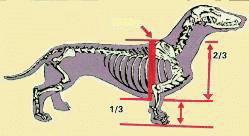 |
According to the standard, the correct proportion is 1/3 of the total distance is the sternum to the ground, and 2/3 of the distance is the whithers to the sternum. |
In this diagram we see the different distances from the ground to the sternum:
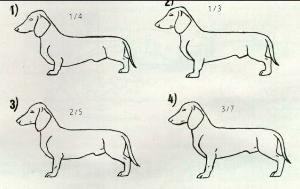 |
1) Distance to the ground 1/4; chest too close
to the ground 2) Distance to the ground 1/3; ideal distance according to the standard 3) Distance to the ground 2/5; too high 4) Distance to the ground 3/7; too high |
The proportion of length must be in relation to
the height. A dachshund that is too long will not have a correct back.
A dachshund that is too short will remind us of a terrier.
THE HEAD
Extended when viewed from above and from each side, decreasing proportionally towards the tip of the nose. The cranium is slightly concave with very little stop (the less the better), terminating in the beginning of a nose that curves slightly upward. The bones and the eyebrows are well pronounced.
The lips are thin and taut, covering well the lower jaw. Scissors bite (upper teeth over lower teeth) or level bite (upper teeth meeting lower teeth) are admitted.
|
|
|
|
Scissors bite |
Level bite |
Undershot and overshot bites should be automatically excluded from any conformation show and from breeding.
|
|
|
|
Prognatismo |
Enognatismo |
Missing teeth should count against the dog, especially missing premolars.
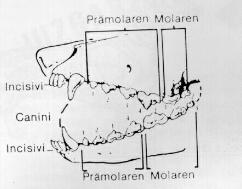 |
Missing 4 or more premolars should exclude the dog from receiving the rating 'good.' Missing 2 or 3 premolars excludes a 'very good.' As for the first missing premolar, the judge may opt for 'very good' or 'excellent' according to the other factors. Between two excellent dogs, the one not missing the first premolar wins. |
The following defects are not as serious, but must exclude the 'excellent rating':
1. The canine teeth do not interlock, but rest on the soft zone of the gums causing discomfort or wounds.
2. The corner of the lips does not reach the first molar, giving a bad impression, especially for hunting dogs.
3. Dogs that have had distemper are characterized by a loss of tooth enamel, which turns the teeth brown. This is an acquired defect, not inherited.
THE EYES
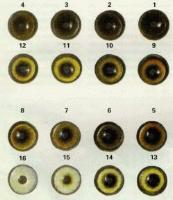 Medium size, oval,
situated on the side with an energetic and friendly expression. Color is
strong dark brown, close to black.
Medium size, oval,
situated on the side with an energetic and friendly expression. Color is
strong dark brown, close to black.
Glass eyes, partridge eyes, and pearl eyes are not defects in gray or dapples, but neither are they desired.
In the frame: the colors 1 - 4 desired for dark coats, 5 - 9 acceptable for reds and light coats, 9 - 15 not desirable, 16 is a glass eye.
The eyes of a dachshund should be almond shaped; large or round eyes give the dachshund a strange expression.
Blue eyes are only tolerated in dapples, and always should reduce the rating by one grade in the final classification.
EARS
High placed and not too far forward, large and well rounded. Ears must not be sharp pointed or narrow. The front edge must touch the cheek. The ear must reach well past the corner of the lips.
NECK
Long enough, muscular, without a double chin, lightly curved at the nape.
Desirable necks are neither too short (not elegant) nor too long (swan neck). Both cause the maximum qualification to be 'very good', as does a double chin.
FRONT LEGS
Long shoulders correctly angled, hard and well muscled. The humorous has the same length as the shoulder blade, forming a right angle with it. Bones are strong and well muscled, fitiing tightly with the ribs while permitting free movement. Radius and ulna curve as little as possible towards the inside. The length of the lower arm must be 1/3 of the height from the ground to the sternum, and 2/3 to the withers.
Feet are closed and well rounded with strong and solid pads. Every foot has five toes, 4 of which are used to tread. Nails are strong.
 Correct position of the front legs.
Correct position of the front legs.
Elbows that open in the front are an undesirable defect.
Front feet that point outward (one or both) do not support the body well. This is undesirable hereditary characteristic in a dachshund, therefore, dogs with this characteristic should not be bred.
Another undesired aspect is that one or more toes turn strongly inwards. Another is that the forefeet extend too far forward.
Feet that do not correctly square generate defects in the dachshund's movement.
|
|
|
|
| Squared feet that generate correct movement | Feet deviate to the outside, 'paddling' | Feet deviate to the inside, causing them to cross when walking |
The desired color for toenails is always black. Brown nails are, however, allowed for brown or red coats. Gray or red (while undesirable) is permitted for gray and light dogs. White nails are never permitted.
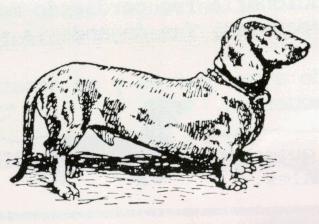 |
In this picture we see the defect produced when the front legs are too short in relation to the back. This causes a rising dorsal line. |
TORSO
The back is possibly the most important part of the dachshund. The withers must be high and long, later they continue straight and then show a slight curve at the kidneys.
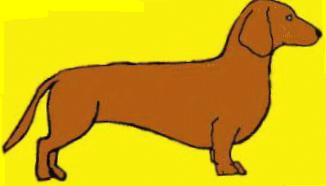
The form of a big curvature upwards from the spinal cord can engender a back like a tent. A downwards curvature in the spinal cord (towards the ground) gives us a saddle back. These two defects are very important because they make it difficult to move well due to the reduction of impulse at the back end. Dogs with these types of backs do not deserve more than 'good' rating and are really a nightmare for breeders.
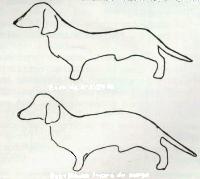 |
The upper figure shows a saddle back, and the lower shows a roached back. |
The breastbone is strong and well pronounced, enough so to cause dimples on each side. The front view of the thorax is oval. Viewed from any other position, we see fullness and width, guaranteeing the ample and correct development of the lungs and heart. The ribs point back.
The correct angle and length of the shoulder and forearm cause the front legs to fall in a perpendicular plane from the thorax, coinciding with the lowest point of the chest.
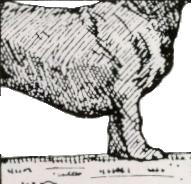 |
Defective alignment: the lowest point of the chest falls behind the front legs. |
In the ideal case, the chest line passes from the neck towards the keel of the chest with a pretty impulse. From there it descends harmoniously towards the lowest point of the chest (coincident with the position of the legs). From this point on, it will rise smoothly until linking with the line of the lower abdomen.
Deformities in the ribs, chest bone, and front leg bones cause deviations. The sternum must be strongly developed and jut out forwards in order to form the side dimples.
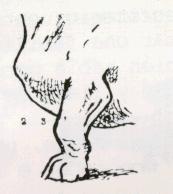 |
This is the so-called 'bird chest' that happens frequently in 'typical' dogs and consists of a keel too pronounced. |
The belly curve of the abdomen will be slightly rising. If the end of the breastbone is too high, the abdomen line will not be correct.
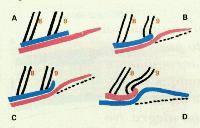 |
a) Normal apophysis xifoides, a correct chest
generating a good ventral line b) Xifoides very compressed, causing the ninth rib to double c) Xifoides directed upward, breaking the harmony of the chest d) Very short sternum, causing the withdrawal of the ninth rib; this is the worst defect of the three. |
BACK LEGS
Rump long and wide, round and well muscled. Hips are not too short, sufficiently developed and slightly inclined. Thighs are strong, with the femur forming a right angle to the hipbone. The foreleg is short and should form a 90 degree angle with the femur.

| Correct | Cow hocks | Toeing in |
Hocks are wide and well pronounced. Feet have four well closed toes, concave just like the front feet. The whole foot rests on the ground (not just the toes). The back feet seen from the front should look completely straight.
A dachshund that steps with the heel will provoke a rocking movement, straight towards the outside. A dachshund that steps on the toes will rock towards the back end.
A good angle in the back legs is fundamental for the dachshund since it affects defects which can appear in the back, rump, and movement. Back legs with narrow hocks are weak and lazy, producing movement towards the outside of the feet. Back legs shaped like a barrel produce a defective movement from outside to the inside. Both defects produce a maximum rating of 'good.'
|
|
|
|
| Correct straight rear legs, stepping correctly. | Hocks too close together, stepping movement towards the outside. |
Pigeon-toed, movement towards the inside. |
THE TAIL
A good rump depends on the well-placed tail. The insertion of the tail must be strong, with all of the vertebrae free from deformity. While moving, the tail should not be higher than the rump line, if it does, normally this will cause rocking from side to side. The high tail is called a 'gay tail' and is not desired since it detracts from the beauty and harmony of the general movement.
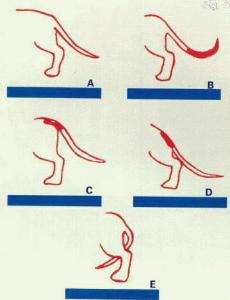 |
a) correct tail and rump
b) hook tail, does not affect the rump (not desirable) c) high rump with the insertion of the tail equally too high d) fallen rump with a bad insertion of the tail e) tail too low, does not affect the rump |
The following malformations should provoke automatic disqualification. Dogs with these hereditary defects should not be bred:
 |
a) double vertebra, (very rare) makes the tail
rigid
b) missing the last vertebra, causes a lump at the tip of the tail c) excessive calcification of a vertebra, breaks the line of the tail d) union of various vertebrae, causes the tail to be rigid e) normal tail f) missing various vertebrae (short tail) g) accidentally broken vertebra (does not exclude breeding since this is not hereditary) |
Another serious defect, but would not exclude breeding, is the curved tail caused by a shortening of the tendons.
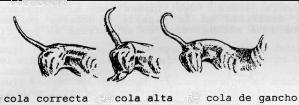
Correct tail High
tail Hook tail
OTHER DEFECTS
Serious: Missing a testicle, or missing both testicles. Missing the last rib in the chest. Dogs with these defects should not be bred. Other defects that limit the maximum rating of 'good': very weak and skinny body, distance from the chest to the ground other than 1/3, duck walk, very open toes, tiny waist, lack of well developed muscles, defective or bad coat.
Not serious: (These exclude an 'excellent' qualification.) Ears badly inserted or that do not reach the cheek, are sharply pointed, or creased. A very pronounced stop. The mouth too sharp or weak (called 'the mole'.) Head short and wide. Eyes that bug out or are round. Excessive weight in the standard variety (over 9 kg (20 pounds) in Europe or 14.5 kg (32 pounds) in USA).
CLASSIFICATION OF THE DACHSHUND ACCORDING TO THE COAT
Smooth
Must be dense, shiny, very close to the body, not showing bald spots anywhere. The tail should be well covered with hair, but not excessive.
Coats allowed are:
One-Color: They can be red or light red, also permitted some black hair mixed in (chocolate coat). Strong reds are favored over the light reds. White spots are not desired, although a tiny blaze on the chest will not disqualify.
Two-Color: The base can be black (most common), gray or white. They must always be accompanied by tan (more or less intense) present on the feet. Optionally tan on the keel, the corner of the mouth and the lower lip, in the inside of the ears, around the anus, and a third of the underside of the tail.
Dapples: The base may be light brown, gray, or white, with dark spots spread irregularly. The spots must be small and colored dark gray, brown, yellowish red or black. It is undesirable that a light background or dark spots dominate.
A brindle dachshund is very rare and has thick dark stripes over a red or tan base.
Care must be taken that bald zones do not appear, usually in the ears (upper wrinkle), in the nose, in the tail, in the lower chest and stomach, and also in the calluses of the elbows.
Wirehair: Seen from afar, they must look like a short hair dachshund. The coat will be of equal length all over the body except in the chin, ears and eyebrows, forming a thick and rough blanket with undercoat.
Regarding the color of the coat, all are permitted, including a small white spot on the chest, although that is not desired for reproduction
Defects: Soft coat, too long or too short of coat, dishevelled hair, curls or waves. Very abundant hair without undercoat, crests or toupees. All of these are cases of 'bad coats' and will obtain a maximum rating of 'good.' Dogs without thick beards and eyebrows will receive a maximum rating of 'very good.' Flag tails or tails with curls and waves will receive a maximum rating of 'good.'
Longhair: This dachshund differs from a shorthair in that the coat is long and silky. The coat in these dogs must be soft, lying flat, and shiny. The coat is longer above the throat, the body, the ears, and notably longer behind the legs, reaching the longest under the tail where it forms a magnificent flag.
The hair must fall below the border of the ears.
It is not desirable, just like other varieties, that the short hair in the
ears forms the so-called leather ears so common in this breed.
Defects: Dry or brittle hair to the touch, an excess of hair at the feet
(making the hunting tasks difficult) too much hair, thick or even length
hair, curls or a sharply pronounced part at the backbone. Also the lack of
a flag tail.
Varieties of size:
Standard: The only limitation is that they must not weigh more than 9 kg (20 pounds) as an adult (14.5 kg (32 pounds) in USA) although for high quality examples a little extra weight will be admitted.

Mini: In order to determine if a dachshund is a mini we must measure the perimeter of the thorax including the highest withers point and the lowest chest point, up to 35 centimeters is permitted.
The adult weight (over 12 months) normally will not be above 4 kg (9 pounds) (5 kg (11 pounds) in USA) although flexibility is allowed so long as the whole picture is harmonious and beautiful.
Dwarf: The same as above except the thorax perimeter must not exceed 30 cm.
Bibliography:
"El teckel: algo mas que un perro" R. de la Rosa.
"Juzgar al teckel" Lotte Gemmeker.
For anything related to this article, write to me at:
Manuel Gutierrez, DVM & Dachshund Breeder